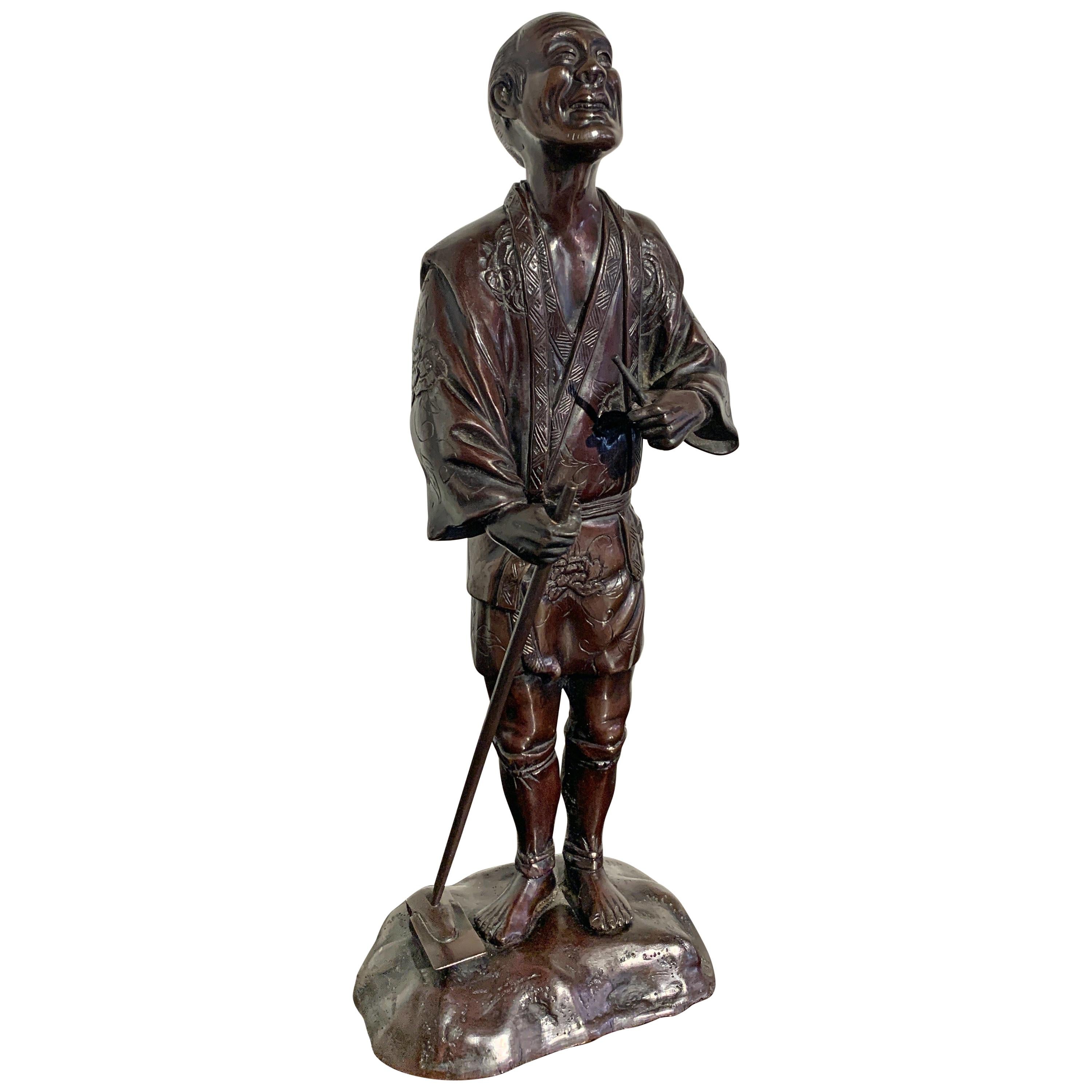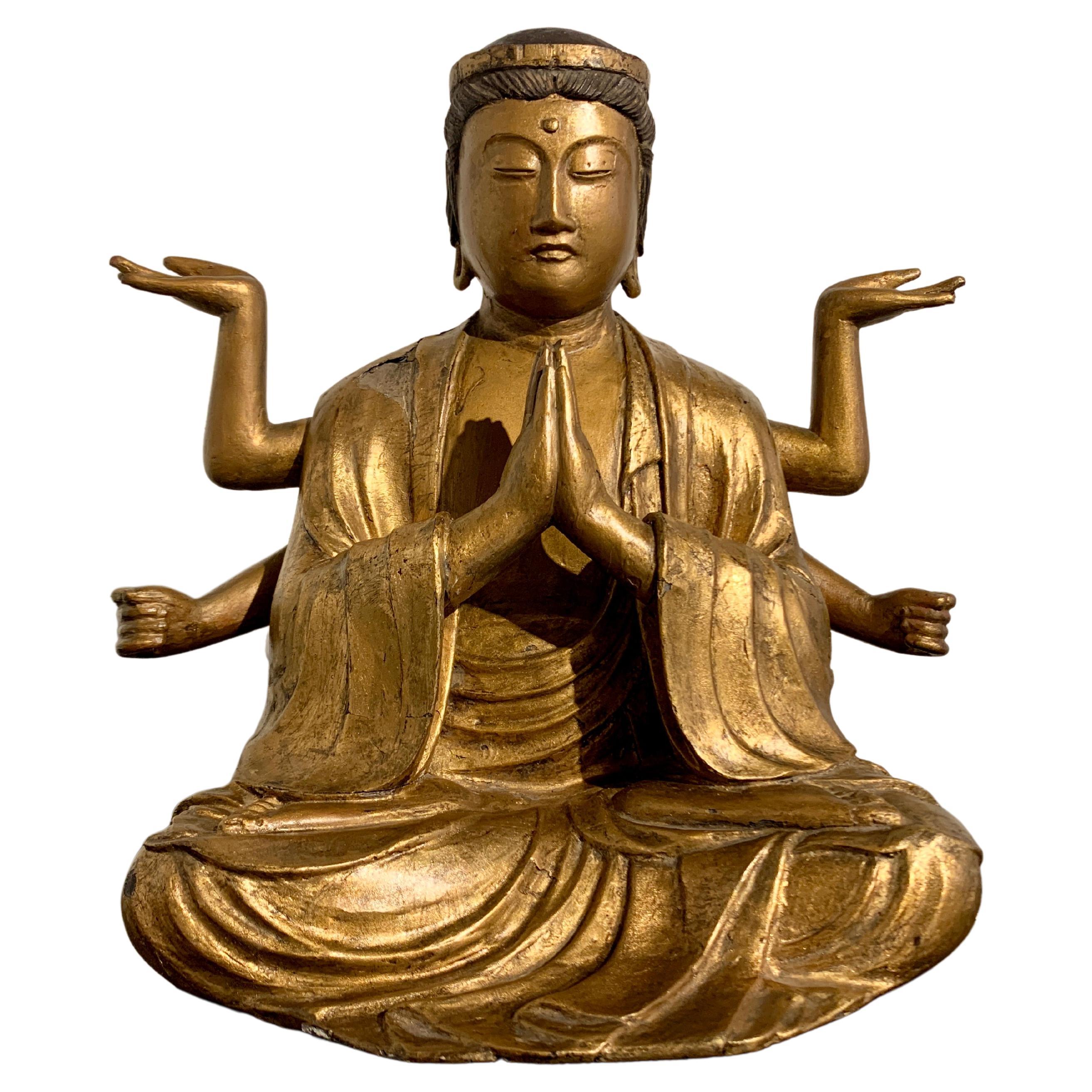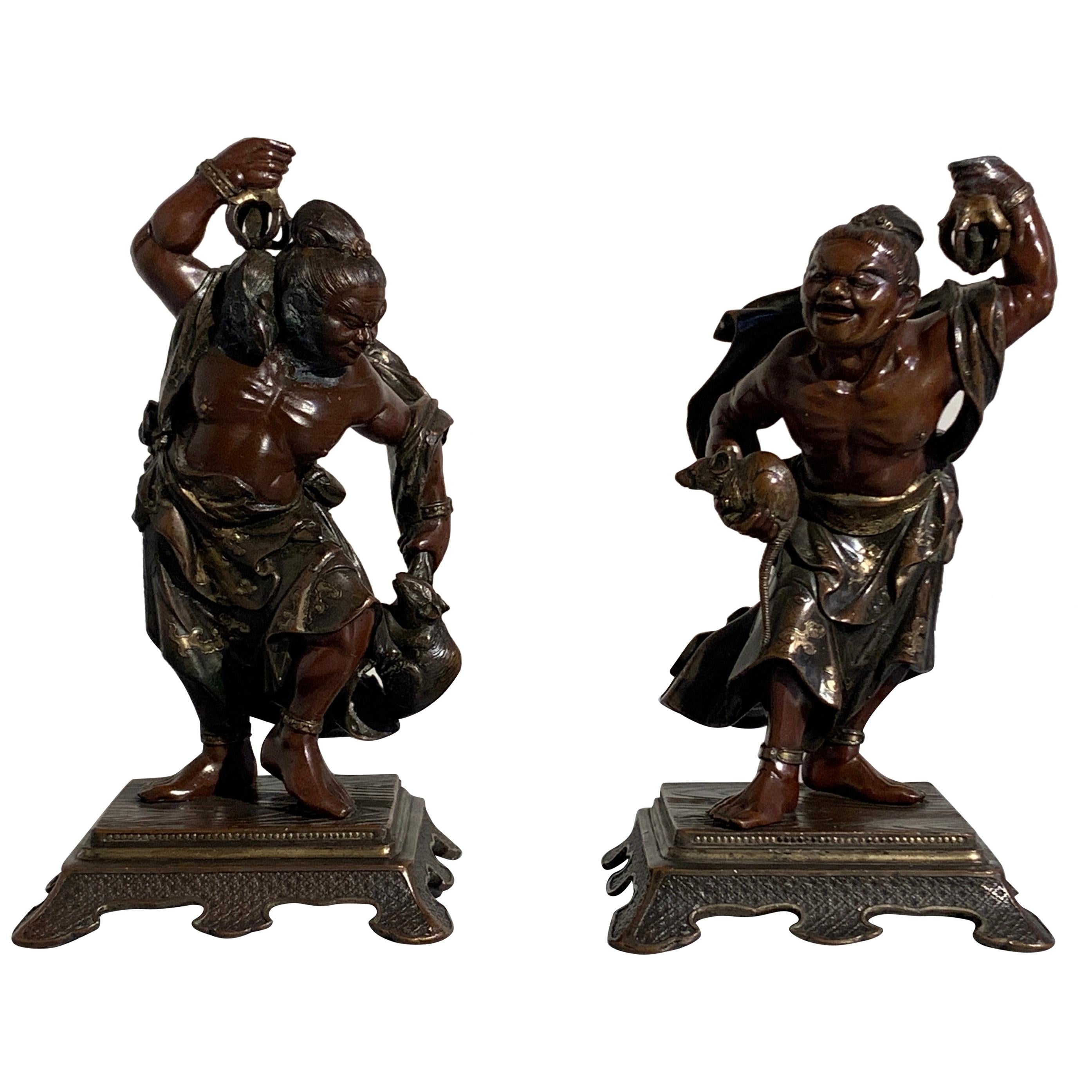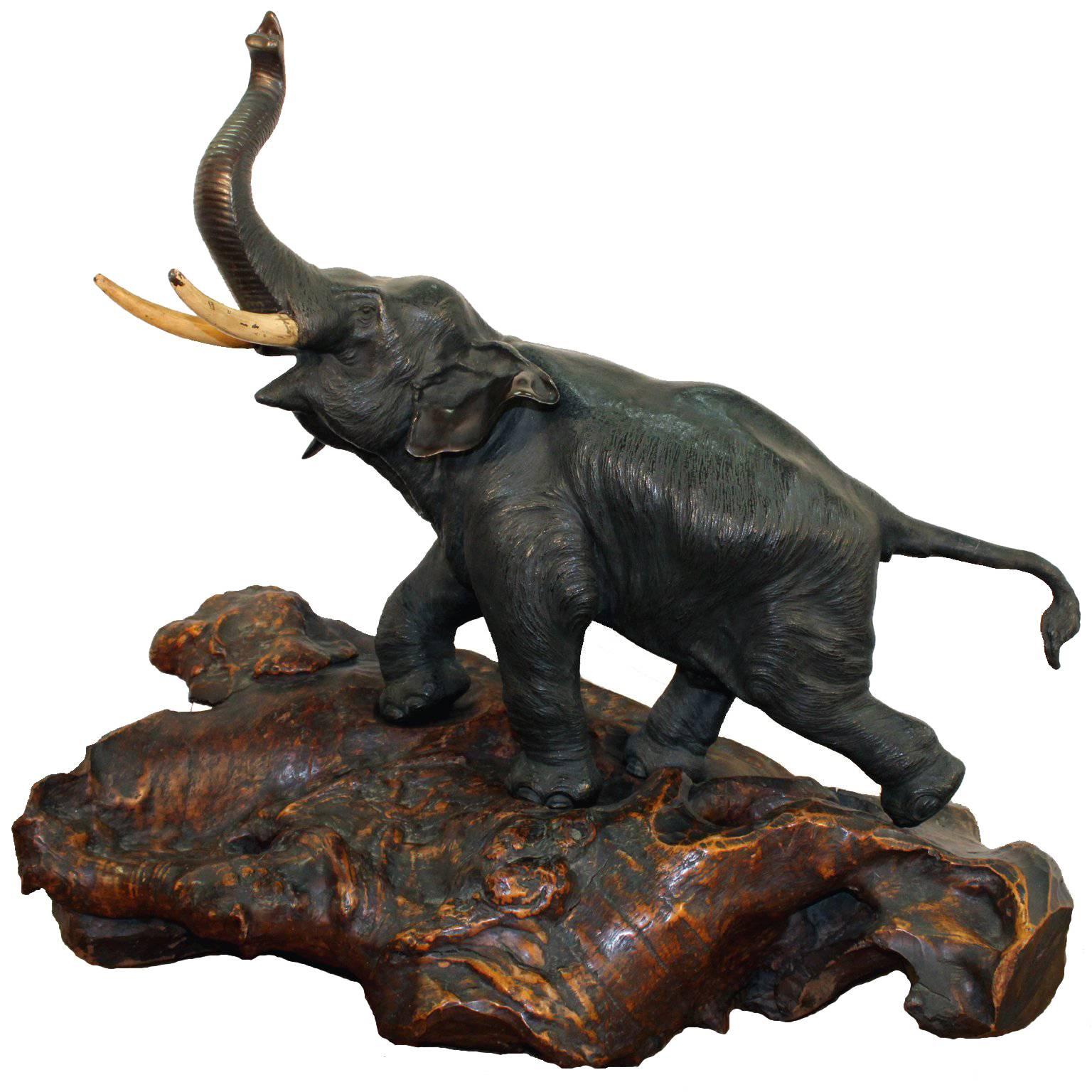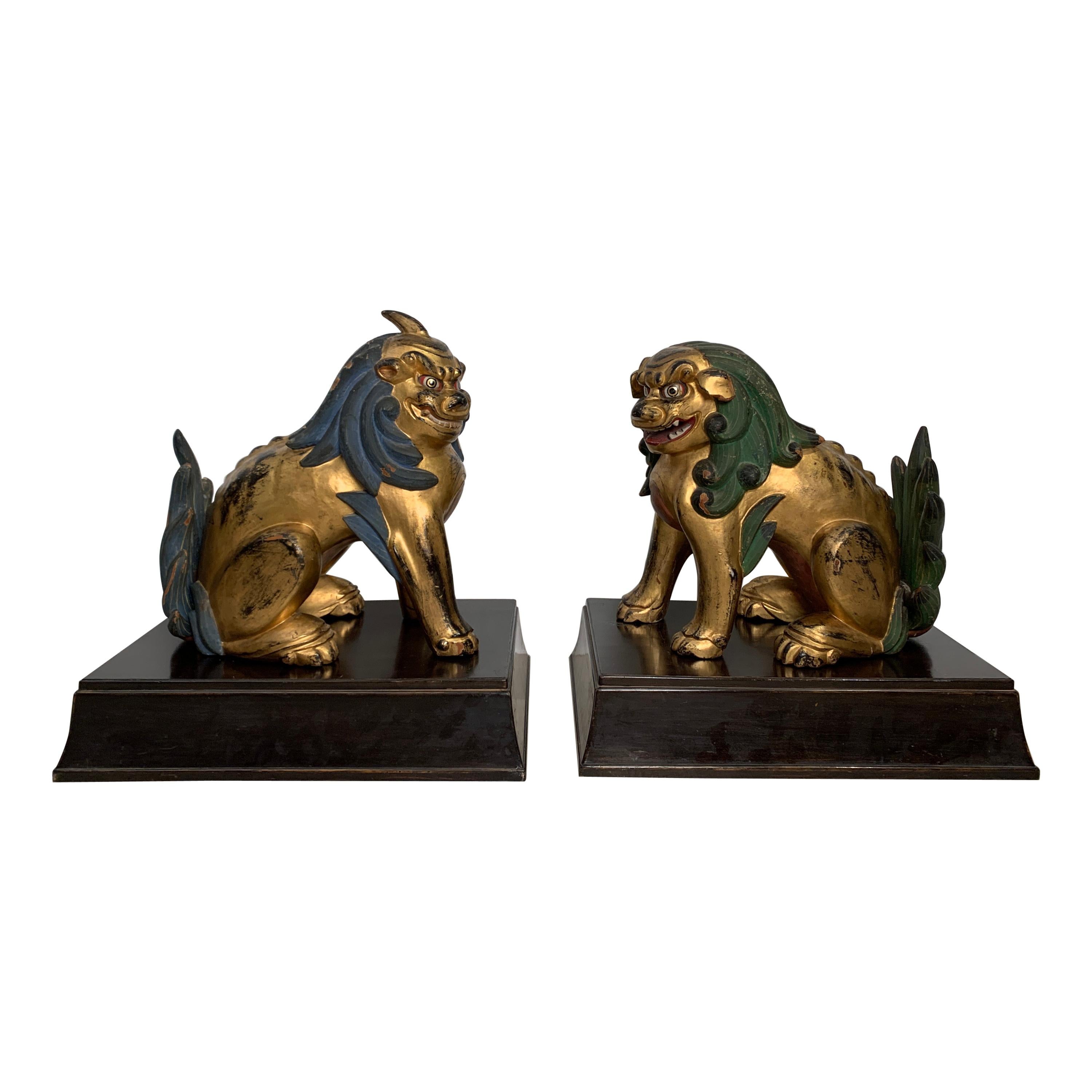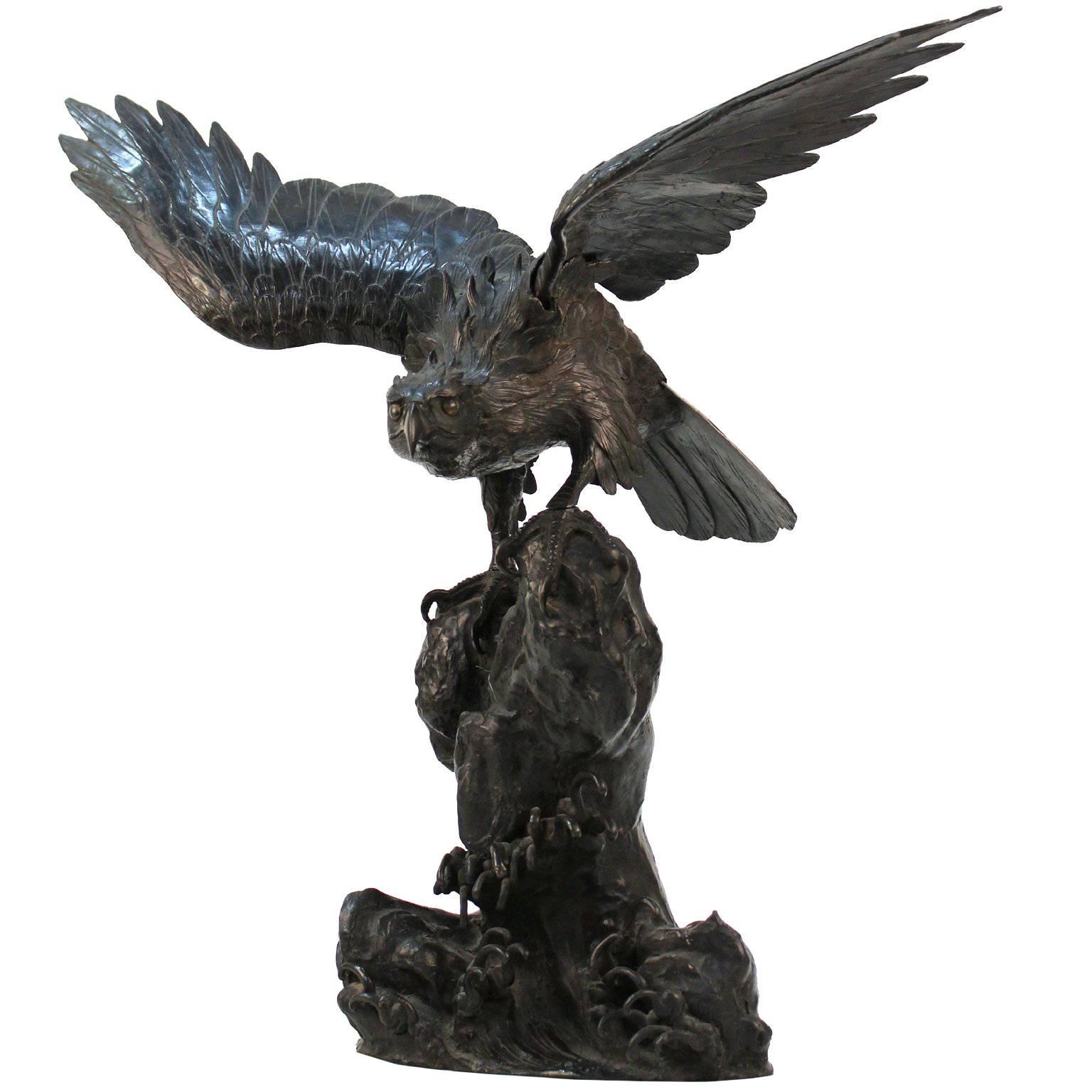Items Similar to Pair of Japanese Gilt Bronze Komainu by Ishikawa Komei, Meiji Period
Want more images or videos?
Request additional images or videos from the seller
1 of 11
Pair of Japanese Gilt Bronze Komainu by Ishikawa Komei, Meiji Period
About the Item
A striking pair of Japanese gilt bronze komainu by the renowned Japanese sculptor, Ishikawa Komei (1852-1913), Meiji period, Japan.
The pair well cast, and robustly modeled. They are portrayed seated on their haunches, with broad, muscular chests, long, flowing manes, and a flame-like tails. The rich gilding further highlighting the strong musculature of these beasts. Their sharp faces, ending in wide, flattened ruyi shaped noses, and mouths set in almost mischievous grins.
Near mirror images, the figures differ only slightly. One lion has his ears pitched forward, and his mouth open, symbolizing the Sanskrit seed syllable "ah" ("a" in Japanese). The other lion has his ears standing upright, and his mouth closed, symbolizing the Sanskrit seed syllable "om" ("um" in Japanese). Together, these two sounds are said to encompass the entire universe, and are equivalent to the Greek "alpha" and "omega".
These lions are based on a pair, carved in wood and dating to the Kamakura period (1185-1333), that originally guarded the Taiho Shrine, Shiga Prefecture, and are now housed in the Kyoto National Museum.
Also known as karashishi, or simply shishi in Japan, in the west they are commonly referred to as foo dogs or foo lions. These ferocious creatures are considered guardians of sacred spaces, and are usually placed at the entrance to shrines or temples.
A nine character inscription in Chinese seal script has been cast to the underside of each lion, reading "Teishitsu gigeiin Ishikawa Komei" (Imperial Artist Ishikawa Komei).
Ishikawa Komei (1852 - 1913) was a renowned Meiji Period artist, known mostly for his carved works in ivory, though he worked across a wide spectrum of media, including bronze, plaster, and paint. Originally trained as a painter of the Kano school, he taught as a professor at the Tokyo School of Fine Arts, where a bust in his honor stands today. When the Imperial Artist system was implemented in 1891, Komei was one the first to receive the honored title. His bronze works are considered quite rare.
Provenance:
Peter Rosenberg / Vallin Galleries
Christie's New York, 2003
- Dimensions:Height: 13 in (33.02 cm)Width: 6 in (15.24 cm)Depth: 9.5 in (24.13 cm)
- Sold As:Set of 2
- Style:Meiji (Of the Period)
- Materials and Techniques:
- Place of Origin:
- Period:
- Date of Manufacture:after 1891
- Condition:Wear consistent with age and use. Minor rubbing to the gilt.
- Seller Location:Austin, TX
- Reference Number:1stDibs: LU89475162313
About the Seller
5.0
Platinum Seller
These expertly vetted sellers are 1stDibs' most experienced sellers and are rated highest by our customers.
Established in 2001
1stDibs seller since 2010
305 sales on 1stDibs
Typical response time: 1 hour
- ShippingRetrieving quote...Ships From: Austin, TX
- Return PolicyA return for this item may be initiated within 7 days of delivery.
More From This SellerView All
- Japanese Tokyo School Bronze Okimono of a Farmer, Meiji PeriodLocated in Austin, TXA very fine and detailed Tokyo School cast bronze okimono (decorative sculpture) of a smiling farmer, Meiji period, late 19th century, Japan. The e...Category
Antique Late 19th Century Japanese Meiji Sculptures and Carvings
MaterialsBronze
- Japanese Gilt Wood Fukukenjaku Kannon, Meiji Period or Earlier, JapanLocated in Austin, TXAn attractive and esoteric Japanese carved and gilt wood figure of Fukukenjaku Kannon, Amoghapasa, Meiji period or earlier, Japan. Fukukenjaku Kannon is portrayed in an usual six...Category
Antique Early 1900s Japanese Meiji Sculptures and Carvings
MaterialsCypress
- Pair of Japanese Cast Bronze Figures of Niō, Meiji Period, Late 19th CenturyLocated in Austin, TXA well cast pair of Japanese mixed metal okimono figures of Buddhist guardians, known as Nio or Dharmapala, protectors of Buddhist faith, Meiji Period, Japan. The smiling bronze g...Category
Antique Late 19th Century Japanese Meiji Sculptures and Carvings
MaterialsBronze
- Pair of Japanese Gilt Wood Komainu, Guardian Lions, Early 20th Century, JapanLocated in Austin, TXA charming and mischievous pair of Japanese carved, gilt and painted komainu, often mistaken for foo dogs or foo lions, Showa Period, 1920's, Japan. The two komainu, or guardian lions, are portrayed seated upon their haunches, heads slightly turned. The two beasts are well carved, with wonderful musculature, flowing manes, and bushy tails. Their faces a mix of ferocious and comical. The eyes of reverse painted glass with gilt highlights. One is a true komainu, (lion-dog), with a horn on its head, and its mouth closed. The other is a shishi, (lion), with its mouth open, and no horn. The komainu sports a mane and tail pigmented blue with gilt highlights. The shishi sports a mane and tail pigmented green with gilt highlights. Both figures richly gilt in gold lacquer. Komainu are protective beings, similar to foo lions or foo dogs...Category
Vintage 1920s Japanese Showa Sculptures and Carvings
MaterialsGlass, Cypress, Wood
- Japanese Miyao Style Gilt Bronze Samurai Archer, Meiji Period, JapanBy Eisuke Miyao 1Located in Austin, TXA spectacular Japanese cast, carved, and parcel gilt bronze sculpture, okimono, of a kneeling samurai archer, signed Kiyotsugu (died 1894), Meiji ...Category
Antique Late 19th Century Japanese Meiji Sculptures and Carvings
MaterialsBronze
- Japanese Bronze Okimono of a Carp, Taisho Period, Early 20th Century, JapanLocated in Austin, TXAn elegant Japanese cast bronze okimono of a swimming carp, Taisho Period (1912 - 1926), early 20th century, Japan. The graceful fish portrayed realistically in motion, as if swimmi...Category
Vintage 1920s Japanese Taisho Sculptures and Carvings
MaterialsBronze
You May Also Like
- Japanese Meiji Period Bronze Elephant Sculpture on Burlwood BaseLocated in New York, NYA Japanese Meiji period bronze elephant sculpture on its original burl-wood base. Old repair to the tail; some paint chips to bronze trunk; unsigned.Category
Antique 1880s Japanese Meiji Animal Sculptures
MaterialsBronze
- Meiji Period Bronze of an Oni Holding a ParasolLocated in Lymington, HampshireThis figural group shows a mendicant Oni with a tattered umbrella and wearing a voluminous shakudo cloak over gilt tiger mask greaves. A smaller Oni wears s...Category
Antique 1890s Japanese Meiji Figurative Sculptures
MaterialsMetal
- Japanese Meiji Bronze Sea-Hawk SculptureLocated in New York, NYA finely-cast large Japanese Meiji-period bronze sculpture of a sea-hawk with stretched-out wings, made in the 1880s. The eyes are gilded; both wings and the body of the hawk are det...Category
Antique 1880s Japanese Meiji Sculptures and Carvings
MaterialsBronze
- 19th Century Meiji Period Bronze of a Boy Collecting Sweet Chestnuts by SeiyaLocated in Lymington, HampshireA charming Meiji period bronze of a boy collecting sweet chestnuts by Seiya, he carries a basket and is looking down at an insect crawling over his hand, he is also evidently wearing...Category
Antique 1880s Japanese Meiji Figurative Sculptures
MaterialsBronze
- Japanese Meiji Period Carved Wood Okimono Man with RabbitsLocated in Newark, EnglandThe charming figure, carved from a single piece of wood is exceptionally carved showing the male figure with humorous expression holding two Rabbits one by the ears and the second under his arm. A third Rabbit stands at the feet of the male looking up, each rabbit with a different expression. The male figure is wearing traditional Japanese attire with his hair tied back stood upon a naturalistic base. The figure dates to the Meiji Period (1868-1912) circa 1900. Notes The Rabbit is one of the 12 animals to feature in the Japanese Zodiac signs which follows the Chinese astrological system along with the Rat, Ox, Tiger, Rabbit, Dragon, Snake, Horse, Goat, Monkey, Rooster, Dog, Pig. Such division is connected with the Jupiter cycle around the Sun, which lasts about 12 years. As 2023 is the year of the Rabbit...Category
Antique Early 1900s Japanese Meiji Sculptures and Carvings
MaterialsWood
- Two Rare Japanese Izumo Clay Dolls of Emperor and Tenjin, Meiji PeriodLocated in Ottawa, OntarioTwo rare Japanese Izumo clay dolls of Emperor and Tenjin, Nara Prefecture, Meiji period. Material and simple execution impart a flavor of antiquity and great decorative power. Empero...Category
Antique Late 19th Century Japanese Meiji Sculptures and Carvings
MaterialsClay
